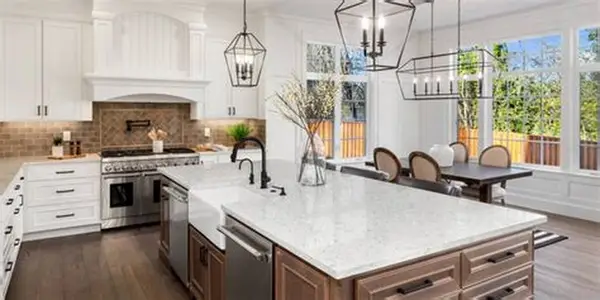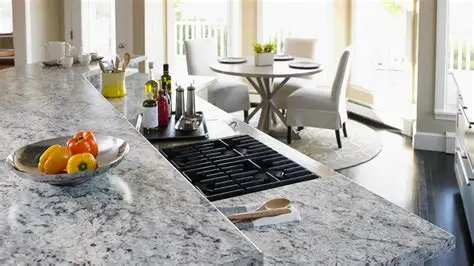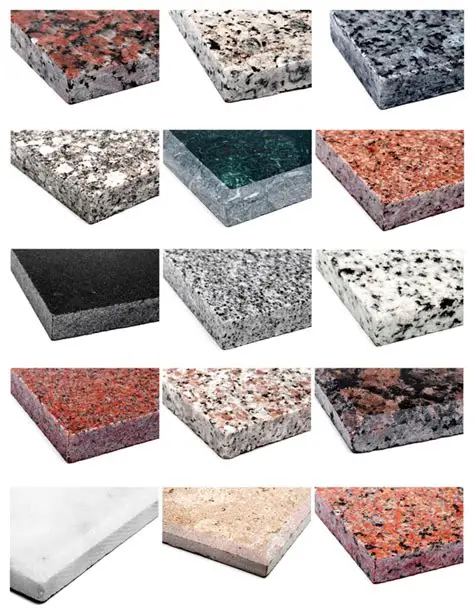While household bleach is a powerful disinfectant, it can dull granite’s polished finish, degrade the protective sealer, and leave cloudy residue—especially on black granite countertops and darker stones. If you want gleaming, long-lasting granite stone in your kitchen or bath, stick with pH-neutral, stone-safe cleaners and proven, non-bleach disinfection methods.
Below you’ll find a complete, semantic-SEO guide that covers the why and the how: daily care, safe disinfection, stain removal, resealing, finish-specific tips (polished, honed, leathered), and answers to common questions—plus when to call a pro.

Granite 101: Why Chemistry Matters
Granite is a natural igneous rock composed primarily of quartz, feldspar, and mica. It’s extremely hard and heat resistant—two reasons it’s beloved for granite kitchen countertops and granite bathroom vanities. Even so, granite is microporous. To resist stains, fabricators apply a penetrating sealer that soaks into the near-surface pores and slows the absorption of oils, wine, coffee, and dye-based spills.
Because granite is porous and sealed, chemistry matters:
- Acids (vinegar, lemon, citrus, many descalers) can etch or haze.
- Harsh alkalines and oxidizers (including bleach) can weaken sealers, fade color enhancers, and leave a cloudy film that’s hardest to hide on white granite countertops and super polished dark stones.
Curious about acids specifically? See Can you clean granite with vinegar?

Why Bleach Is a Risk on Granite
Bleach (sodium hypochlorite) is a strong oxidizer with a high pH. That combo is excellent at killing germs, but not ideal for sealed, polished stone.
What can go wrong:
- Sealer breakdown: Repeated exposure shortens sealer life, making granite more absorbent—so stains set faster.
- Finish dulling: Bleach can micro-etch or leave a haze, robbing polished granite of its crisp reflection.
- Streaking & film: Especially visible on black and grey granite countertops after the solution dries.
- Adjacent material damage: Bleach fumes/splashes can discolor grout, wood finishes, paint, or corrode metal fixtures.
Important: Never mix bleach with acids or ammonia. Mixing cleaning chemicals can release toxic gases.
When People Reach for Bleach (and Better Alternatives)
Many homeowners assume bleach is the only “real” disinfectant. In reality, granite does not need bleach to be sanitary. Daily cleaning with a pH-neutral stone cleaner removes the biofilm that microbes cling to, and 70% isopropyl alcohol provides effective disinfection without the finish-dulling side effects.
Safer granite-friendly options:
- pH-neutral stone cleaner (for daily cleaning).
- 70% isopropyl alcohol spray for targeted disinfection (brief 2–3 minute dwell, then rinse and dry).
- Baking-soda poultice for oil stains; baking soda + 3% hydrogen peroxide for coffee/wine (organic) stains.
- Stone-labeled disinfectants (if the product specifically says it’s safe for natural stone).
Your Daily Granite Cleaning Routine (No Bleach Needed)
- Dry wipe
Remove crumbs and grit with a clean microfiber cloth. This reduces swirl marks on polished finishes. - Spray cleaner
Use a pH-neutral stone cleaner or warm water with 1–2 drops of mild, dye-free dish soap. Mist lightly—don’t flood seams. - Wipe methodically
Work in overlapping passes from backsplash to counter edge. Flip the cloth as it loads up. - Rinse
Wipe with clean water (distilled water is best on dark stones to avoid mineral spots). - Buff dry
The 10-second secret to a streak-free shine—especially on black granite countertops and leathered granite near cooktops.
How to Disinfect Granite (Without Bleach)
- Spot disinfection: Lightly mist 70% isopropyl alcohol. Let it dwell for 2–3 minutes, rinse with clean water, and buff dry.
- High-touch zones: Handles, around sinks, landing zones for groceries—clean first, then disinfect.
- Avoid: Undiluted hydrogen peroxide, chlorine bleach, quats, and ammoniated glass cleaners unless the label explicitly says “stone-safe.”
Stain & Spill Playbook (Stone-Safe Fixes)
Oil (olive oil, butter):
Apply a baking soda + water poultice (peanut-butter thickness). Cover with plastic wrap, pierce a few holes, wait 24–48 hours, then remove, rinse, and dry. Repeat as needed.
Organic (coffee, wine, tea, berries):
Use baking soda + 3% hydrogen peroxide as the poultice liquid. Same application steps.
Metal rust:
Rust removers can be acidic. Use only rust products marked stone-safe and spot-test—or call a professional.
Tip: If a heavy object falls on a seam, granite can develop a hairline fracture. Learn more here: Can granite countertops crack?
Sealing Granite: The Other Half of “Clean”
Do granite countertops need sealing?
Most do—especially lighter colors and honed granite. Sealers don’t make stone stain-proof, just more stain resistant.
Water-drop test (once per season):
Place a teaspoon of water on the surface. If it darkens within 5–10 minutes, it’s time to reseal. If it beads for 30+ minutes, you’re still protected.
Reseal basics:
Clean → dry → apply per label → buff off all excess before it dries on the surface → allow full cure time (often 24 hours) before heavy use.
Finish-Specific Advice
Polished granite:
Least porous and most reflective. Shows streaks if not buffed dry; avoid soap build-up.
Honed (matte) granite:
More absorbent and shows fingerprints/oils. Reseal a bit more often and favor distilled-water rinses to prevent mineral films.
Leathered/antiqued granite:
Subtle texture can hold grime near cooktops. Use a soft nylon brush with pH-neutral cleaner, then rinse and towel dry.
Special Situations: If You Must Use Bleach (Not Recommended)
Some health guidelines suggest diluted bleach for non-stone surfaces. If you’re in a situation where a brief, very diluted bleach wipe is absolutely unavoidable:
- Dilute heavily (follow the most conservative label instruction).
- Limit contact time—no long soaks or puddling.
- Rinse thoroughly with clean water—twice.
- Buff dry immediately with microfiber.
- Re-test your sealer the next day; reseal if water no longer beads.
Again, the safer and simpler route is 70% isopropyl alcohol after routine cleaning.
Granite vs. Quartz, Marble & Soapstone: Bleach at a Glance
- Granite vs quartz countertops: Neither likes bleach. Quartz has resin binders that can lighten or discolor with harsh chemicals and heat; granite has sealers and polish to protect. Both prefer pH-neutral cleaners for daily use.
- Granite vs marble: Marble is calcium-carbonate based and reacts to acids even faster. Bleach also risks finish damage.
- Granite vs soapstone: Soapstone is dense and non-porous, more tolerant of chemicals, but still best cleaned with gentle products to preserve oiling/patina.
If you’re exploring surfaces for affordable granite countertop options, natural stone countertop comparison (granite vs marble vs soapstone vs quartz) should include care requirements, not just price per square foot.
Cost & Value: Preserve the Investment
Whether you bought through wholesale granite suppliers or a boutique showroom, proper care delivers long-term value: fewer professional resurfacings, better stain resistance, and that “installed yesterday” shine—without harsh chemicals.
If you’re planning a remodel (new granite backsplash designs, larger island, or pairing granite with cabinet colors), safe handling and transport matter. Pros use the right gear to protect slabs and finished tops:
- See specialized gear at Toolrange.
- For jobsite handling, the Aardwolf Forklift Boom FB1-2720 helps move heavy pieces safely during fabrication and installation.
FAQs About Bleach and Granite
Can I use disinfecting wipes?
Only if the label says stone-safe. Many contain ammonia or harsh quats. Cleaning first, then using 70% isopropyl alcohol is the safer play.
What about occasional bleach in a pinch?
Minimize contact, rinse immediately, and recheck the sealer. But as a rule, skip bleach and choose stone-safe methods.
My counters look cloudy after cleaning—did I ruin them?
Cloudiness often comes from soap film or hard-water residue. Try a pH-neutral cleaner followed by a distilled water rinse and microfiber buff. Persistent haze may require a pro’s polish and reseal.
Do I need to seal black granite?
Many dense dark granites still benefit from sealing—especially honed finishes. Use the water-drop test to decide.
Are there one-bottle “miracle” cleaners?
Avoid all-purpose products that don’t specify natural stone safe. The wrong chemistry can quietly shorten your sealer’s life.
Quick Decision Guide (Bookmark This)
Do this:
- Clean daily with a pH-neutral stone cleaner or warm water + a drop of mild soap.
- Rinse with clean water; buff dry.
- Disinfect with 70% isopropyl alcohol, brief dwell, rinse, and dry.
- Treat stains with a baking-soda poultice matched to the stain type.
- Reseal when the water-drop test suggests.
Don’t do this:
- Don’t use bleach, vinegar, citrus, or ammoniated glass cleaners.
- Don’t scrub with steel wool or abrasives on polished granite.
- Don’t set hot cookware directly on seams or overhangs; use trivets.
- Don’t slide heavy appliances—lift and place carefully.
The Bottom Line: Skip Bleach, Keep the Brilliance
You can keep clean granite countertops hygienic and gorgeous—without bleach. The winning formula is simple: pH-neutral daily cleaning, alcohol-based disinfection when needed, correct stain-removal techniques, and periodic sealing. That’s how you protect the finish, avoid costly restoration, and enjoy the timeless look that keeps granite vs quartz countertops debates lively year after year.
Helpful Links & Further Reading
- Safe cleaning do’s and don’ts: Can you clean granite with vinegar?
- Structural concerns & mishaps: Can granite countertops crack?
- Pro tools & transport: Toolrange • Aardwolf Forklift Boom FB1-2720

